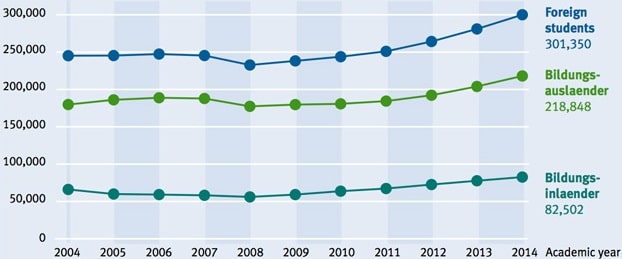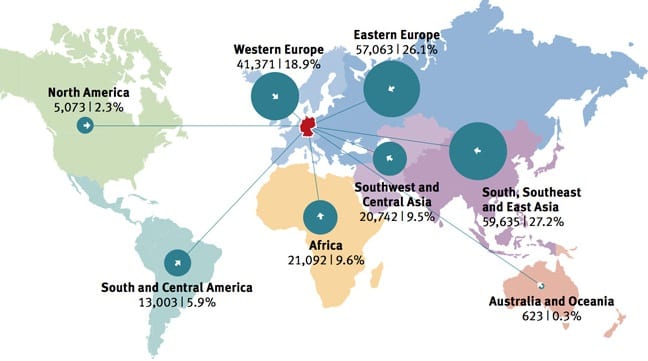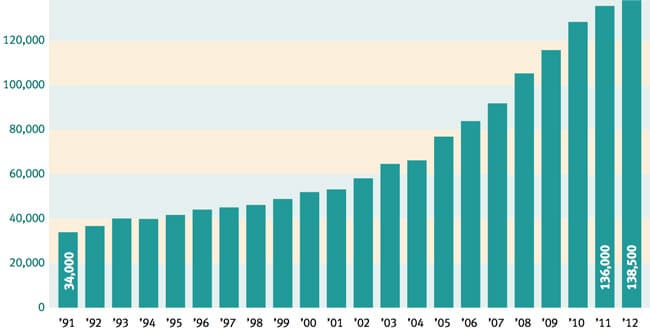German student mobility continues to increase
The latest report from the German Academic Exchange Service (DAAD) provides a detailed view of student mobility in and out of Germany. It shows that the country’s foreign enrolment is tracking well towards a longer-term goal to host 350,000 students by 2020, having grown by about 7% between 2013 and 2014. Outbound mobility, meanwhile, is increasing as well, albeit at a slower pace. The 138,500 German students who studied abroad in 2012 represents a 1.4% increase over 2011.
Germany as a global study destination
As we reported last year, the country’s growing enrolment base places Germany among the top study destinations in the world, after the US and UK certainly, but contending with China, France, and Australia for the number three rank among major global destinations.
Students are drawn by Germany’s status as a leading world economy, but also by the modest tuition fees for international students as well as immigration policies that support the interests of a majority of students in staying and working in Germany after graduation.
DAAD’s annual Wissenschaft weltoffen Kompakt report for 2015 ("Facts and Figures on the International Nature of Studies and Research in Germany") reports on trends for two distinct categories of foreign higher education students: Bildungsinländer ("students of other nationalities who have obtained their higher education entrance qualification in Germany") and Bildungsausländer ("students of other nationalities who have obtained their higher education entrance qualification outside Germany").
The distinction is interesting in that Bildungsinländer have a longer history in the country and have completed some preparatory studies in Germany before beginning their higher education programmes. Some of these students may be in the process of immigrating to Germany, or may have chosen to begin their studies in the country at an earlier point to improve their admissions prospects or their chance for success in more advanced studies.
Bildungsausländer, on the other hand, complete their admissions requirements outside the country and come to Germany primarily to pursue higher education studies.
As the following chart reflects, the Bildungsausländer group accounted for 72.6% of Germany’s foreign higher education enrolment in 2013/14. In total, foreign students made up 11.5% of the country’s higher education enrolment for the academic year.


Germany as an outbound market
The DAAD report for 2015 also focuses on two categories of outbound students: those who go abroad to pursue a complete degree programme and those who go for a short, study-related visit abroad. Of the second group, the report notes, "There are no official statistics regarding the total number of temporary study-related visits abroad by German students, [these] can currently only be estimated on the basis of student and graduate surveys. The only exception is the official data available relating to the subsection of temporary study or placement visits abroad as part of the EU’s Erasmus programme. These Erasmus visits represent about one third of all temporary study-related visits abroad made by German students."
DAAD draws on the Erasmus data along with findings from three student surveys to determine that around a third of German graduates in 2009 and 2010 had completed at least one study-related visit abroad, with roughly a third of these being for three months or longer.
This means that Germany has already met Europe’s 2020 target for outbound mobility (that 20% of graduates have some international experience), and is tracking well to more aggressive national targets (that a third of graduates study abroad for at least three months and that half have some study experience abroad).
As the following chart reflects, the percentage of German graduates who have completed a study visit abroad has increased significantly over the past decade or so. The chart tracks participation by students from universities as well as from Fachhochschule (higher education institutions with a specific subject focus such as engineering or business). While the numbers trend slightly differently for the two types of institutions, the overall participation in study visits abroad rose from around 20% in 1991 to 30% in 2012.


















